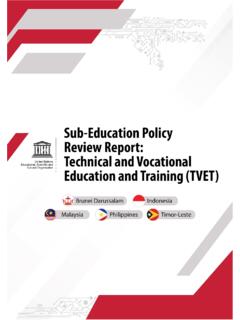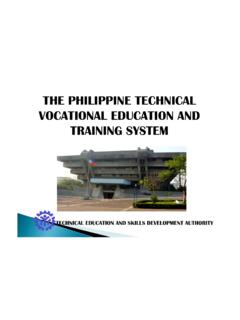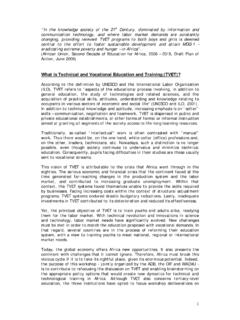Transcription of Costs and Benefits in Vocational Education and Training
1 Costs and Benefits in Vocational Education and Training Kathrin Hoeckel EDU/EDPC/CERI(2008)3 2 TABLE OF CONTENTS Costs AND Benefits IN Vocational Education AND Training .. 3 Tentative conclusion .. 3 Introduction .. 5 Context affects VET Costs and Benefits .. 5 Methodological limitations .. 5 Costs associated with Vocational Education and Training .. 6 Defining the Costs of VET .. 6 Who pays for VET? .. 6 Forms of government intervention .. 7 Employer engagement in VET .. 8 Individual student contributions .. 9 Benefits associated with Vocational Education and Training .. 10 Defining the Benefits of VET .. 10 Determinants of VET Benefits .. 10 Employer perspective.
2 11 Individual returns to VET .. 12 REFERENCES .. 15 EDU/EDPC/CERI(2008)3 3 Costs AND Benefits IN Vocational Education AND Training Tentative conclusion The evidence gathered in this VET cost benefit literature review leads to the following preliminary conclusions that will be used to inform subsequent research. 1. An aggregate cost-benefit analysis or general conclusions applicable to all OECD countries are hardly feasible for substantive and methodological reasons VET systems, their definition and forms of provision vary substantially across countries.
3 Lack of standardized approach to data collection limits comparability; missing evidence. 2. Understanding the determinants of VET Costs and Benefits is as important as knowing the Costs and Benefits themselves Determinants include: Labour market regulations, influence of trade unions, nature of demand for skills, industry sector or occupation, types of VET provision, general versus specific Training . Example: salaries of Swiss trainees are higher than those of their German counterparts but only Swiss firms reap net Benefits ; reason: unlike Germany, the flexible labour market in Switzerland does not inhibit turnover, therefore Swiss firms have to make sure trainees are productive.
4 3. Various direct and indirect Costs to different stakeholders have to be taken into account School based VET Workplace Training Individual Student fees Charges for material/equipment Accept lower wages Opportunity Costs (forgone earnings as unskilled worker) Employer Paid time off for staff/trainees Financial support for staff/trainees Pay wages (and labour Costs ) higher than productivity Mistakes by inexperienced trainees, wasted resources and time of experienced workers In-house Training courses (material, special clothing, teacher salary, administration) State Funding of Education institutions Scholarships, vouchers, grants and loans Subsidies to Training firms Financial concessions to employers (tax allowances) EDU/EDPC/CERI(2008)3 4 4.
5 An assessment of VET (as investment) should consider both short- and long-term Benefits While Costs are typically expected up front, Benefits might arise at different points in time. Benefits may be difficult to quantify and hard to disentangle from other variables affecting performance and productivity. Individual* Employer Society Short-term Benefits Employment chances Earning levels Work satisfaction Drop out less likely from Vocational than general courses (US data) Higher productivity from well trained workforce Saved Costs from recruiting external skilled workers (incl.)
6 Time for integration and risk of hiring a person not known to the company) Saved expenses for social Benefits (unemployment as consequence of failed transition from Education to work) Long-term Benefits Flexibility and mobility Lifelong learning (more likely to receive Training and upgrade skills later in life) Supply Benefits ( image improvement) Less turnover (no need for re- Training of new workers) Externalities from productivity gain due to better Education Increase in tax income from higher earnings *VET students abilities differ systematically from academic students what is the right counterfactual? 5. The question Is it worthwhile to invest in VET? remains open at this stage VET is costly compared to general Education .
7 However: blue-collar workers ( VET graduates) are still needed in today s economies. A more suitable question could be: How can the provision of VET be made most cost-effective? This general question translates into concrete guiding questions for further analytical work on VET and country visits such as: Who should pay for VET? Where and how should VET be provided? Can context variables determining the cost-benefit relationship be influenced? EDU/EDPC/CERI(2008)3 5 Introduction 1.
8 This paper has been prepared as part of the analytical phase of the OECD policy review on Vocational Education and Training (VET). Its purpose is to identify the different Costs and Benefits involved in the provision of initial VET1 and the difficulties involved in assessing them from a comparative point of view. At this stage the paper is provisional and makes no claims to present exhaustive information on a subject of such broad scope. During the course of the VET policy review, it will be updated and evidence from other elements of the project, in particular the international questionnaire incorporated. Countries are invited to provide feedback and contribute additional research and data to the evidence base.
9 2. The paper draws from different approaches to the analysis of VET Costs and Benefits using evidence from OECD countries. It underlines the importance of examining the background factors which determine the cost-benefit relationship and discusses some methodological limitations. The remainder of the paper is divided into two parts. The first deals with VET Costs and their distribution between different stakeholders. The second sets out the different types of Benefits and their determinants and sheds light on the evidence regarding both the employer and individual returns to VET. Context affects VET Costs and Benefits 3. The definition and provision of VET varies substantially across OECD countries.
10 VET systems range from highly regulated structures in the dual system countries to situations like in the UK, where Vocational Education is highly fragmented and apprenticeships do not have a legally defined identity (Steedman, 2001). Costs and Benefits of alternative forms of provision differ accordingly. As a consequence, it is difficult to carry out an aggregate cost-benefit assessment or to come up with general conclusions valid for all OECD countries. 4. VET systems are embedded in national economic structures which add to their heterogeneity. Flexibility or rigidity of the labour market has an impact on employee turnover and on employers capacity to protect themselves against free-riding and poaching.

















